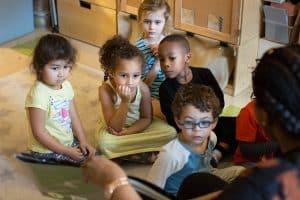4 Ways We Can Fund Personalized Learning to Create More Equitable Schools
CompetencyWorks Blog

This post originally appeared at Education Post on September 12, 2017.
Budget shortfalls in states are framing a new angle on educational equity conversations. It is no longer simply about what is right, but what is fiscally necessary for a state to grow and thrive.
Studies from Erik Hanushek and the National Bureau of Economic Research show, state economies live and die by the extent to which they drive educational success for all their learners.
Fiscal responsibility at the state level is vital for the academic success of all children, but especially for students of color, students from low-income families, students with disabilities, English-language learners, students living in foster care and students currently without a permanent residence.
These and other student groups who have been underserved, seemingly as tradition in public education, are more likely to attend what Johns Hopkins University researcher Robert Balfanz calls “dropout factories”—schools in which less than 60 percent of students graduate on time.
For example, the national, on-time graduation rate for students with disabilities and English-language learners is currently under 65 percent. Given the widespread use of Balfanz’s “dropout factory” definition, this means that we could be on the verge of classifying our national education system as a dropout factory for the aforementioned student groups.
HERE’S WHERE PERSONALIZED LEARNING COMES IN
This reality demands that we go beyond tweaks to the system and work towards wholesale reforms.
Personalized learning is a relatively new, innovative approach to teaching and learning that provides flexibility in how students are given the opportunity to learn, demonstrate their learning and bring their own personal values, experiences and culture into the classroom.
When implemented well, personalized learning is a system that prioritizes students receiving the support they need—academic, socio-emotional, or otherwise—so that each and every child can maximize their potential.
Nevertheless, while there is some cause for optimism, the evidence has not borne out the full promise of the approach.
The question is whether the problem is with personalized learning or our strategy to resource and implement it? We would pose that it may be the latter.
HOW WE CAN GET IT RIGHT
Effective implementation of personalized learning strives to value the unique and exceptional skills that all children bring into the classroom, and organizations such as the National Center for Learning Disabilities (NCLD) have written on how to make that possibility a reality.
Instead of assuming the stance of traditional education models, which are designed to meet the needs of the “average learner,” only to have to redesign and retrofit the system later to accommodate other students, personalized learning—when implemented well—can accommodate all children at the outset.
The promising alternative to this approach starts with the needs of and best practices in serving traditionally disadvantaged students and then applies the lessons of those approaches to meet the needs of all other learners.
There are several best practices policymakers in legislatures and state education agencies can leverage that are more aligned with this approach:
- Funding Integration and Alignment: Align different funding streams to increase achievement for all students, close group-based opportunity gaps and support best practices in teaching traditionally disadvantaged populations.
- Ensuring Equitable Access to Resources: Provide access to learning opportunities such as Advanced Placement (AP), International Baccalaureate (IB), career technical education and higher level coursework for all students through sufficient investments in accommodations and accessibility for all learners, through strategies such as universal design for learning.
- Providing Additional Resources to Meet Additional Needs: Deliver state categorical or supplemental aid to the school sites to be spent toward supporting the students whose educational needs initially generated the additional state aid. These targeted and supplemental investments can include support around professional development in working with these populations, learning management systems that track their progress and other investments to ensure their success.
- Leveraging Purchasing Power to Advance Equity-Based Products: Use state dollars to create equity-based professional-development opportunities for district and school leaders, universal-design-learning professional development for teachers, and high-quality technology platforms, textbooks and learning materials that serve the needs of all students.
In many ways, the resource allocation strategies highlighted above are not new to personalized learning—they’re part of the successful implementation of any equity-based initiative. What is new is flexibility—both the flexibility states have been provided through the Every Student Succeeds Act (ESSA) and the flexibility schools and educators are provided to effectively implement it.
As part of this flexibility, personalized learning certainly has potential to disrupt the status quo and achievement gaps, but like efforts before it, that potential is only realized through a combination of effectively trained and supported educators and strategic decisions by policymakers.
See also:
Bryant Best works for the Innovation Lab Network at the Council of Chief State School Officers (CCSSO).
Ace Parsi is the Personalized Learning Partnership Manager at the National Center for Learning Disabilities (NCLD), where he works to ensure students with disabilities fully benefit from initiatives aiming to personalize learning for all students